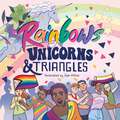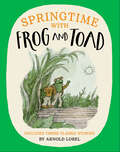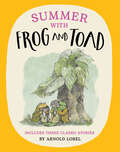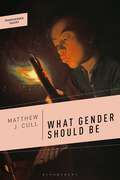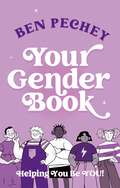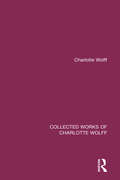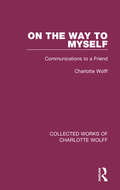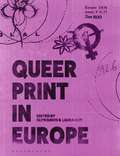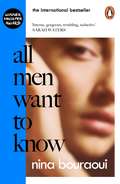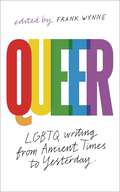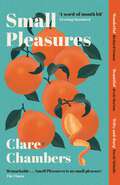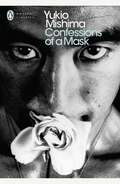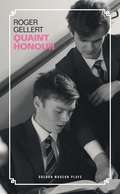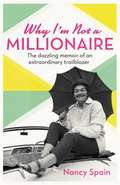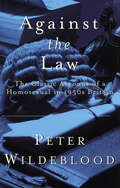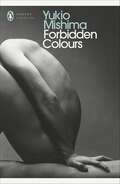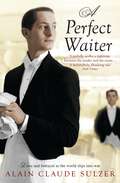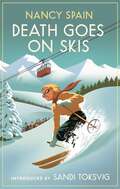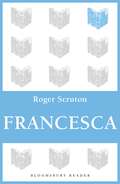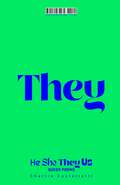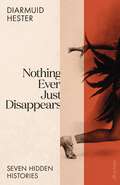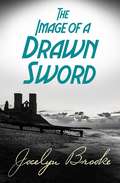- Table View
- List View
Rainbows, Unicorns, and Triangles: Queer Symbols Throughout History
by Jessica Kingsley PublishersIn the past, being different has often been dangerous, and people couldn't always be open about how they wanted to dress, what gender they wanted to be, and who they loved...Within these pages, you'll learn about how LGBTQIA2S+ people have used signs and symbols throughout history to communicate with each other, create safe spaces, and celebrate who they are!You'll recognise the rainbow flags of Pride Month, but what about the Labrys, the Lambda or the Lavender Rhino? This beautifully illustrated guide takes you on a journey through everything from the green carnations of Oscar Wilde and the violets of Sappho to the black rings of asexuality and the reclaimed pink triangles of persecution. A wonderful guide for children 5+ to the visual worlds of queer life.
Springtime with Frog and Toad
by Arnold LobelFrog and Toad stories have delighted both children and adults for more than fifty years, celebrating friendship and life in the most joyful and heart-warming way. This charming collection, which brings together three springtime stories, is the perfect seasonal gift for children.
Summer with Frog and Toad
by Arnold LobelFrog and Toad stories have delighted both children and adults for more than fifty years, celebrating friendship and life in the most joyful and heart-warming way. This charming collection, which brings together three summer stories, is the perfect seasonal gift for children.
Twenty-First-Century Readings of E. M. Forster's 'Maurice' (Liverpool English Texts and Studies #83)
This is the first book-length study of Forster’s posthumously-published novel. Nine essays focus exclusively on Maurice and its dynamic afterlives in literature, film and new media during the twentieth and twenty-first centuries. Begun in 1913 and revised over almost fifty years, Maurice became a defining text in Forster’s work and a canonical example of queer fiction. Yet the critical tendency to read Maurice primarily as a ‘revelation’ of Forster’s homosexuality has obscured important biographical, political and aesthetic contexts for this novel. This collection places Maurice among early twentieth-century debates about politics, philosophy, religion, gender, Aestheticism and allegory. Essays explore how the novel interacts with literary predecessors and contemporaries including John Bunyan, Oscar Wilde, Havelock Ellis and Edward Carpenter, and how it was shaped by personal relationships such as Forster’s friendship with Florence Barger. They close-read the textual variants of Forster’s manuscripts and examine the novel’s genesis and revisions. They consider the volatility of its reception, analysing how it galvanizes subsequent generations of writers and artists including Christopher Isherwood, Alan Hollinghurst, Damon Galgut, James Ivory and twenty-first-century online fanfiction writers. What emerges from the volume is the complexity of the novel, as a text and as a cultural phenomenon.
What Gender Should Be (Transgender Theory)
by Matthew J. CullWhat is gender? More importantly, what should gender look like in the 21st century? This book brings together philosophy with insights from feminist and transgender theory to argue for a position called 'ameliorative pluralism' about gender: that there should be more than two genders, and that each gender term should have multiple meanings. What Gender Should Be develops an explicitly political version of conceptual engineering (the modification of our representational devices in light of our purposes) based on the work of Otto Neurath and Audre Lorde to examine and critique existing theories of gender. It further produces novel and powerful arguments against those traditions of thinking about gender that arose after the 1980s – family resemblance theories, Butlerian performativity, deflationism, scepticism, and nihilism about gender – developing each tradition in detail before suggesting that each is insufficient for thinking about and doing justice to contemporary transgender identities and politics. Instead, Matthew Cull argues that we should be pluralists about gender, developing and arguing for a position that more apt for contemporary transgender and feminist activism. The 21st century requires a new way of thinking about gender. What Gender Should Be sets out to provide it.
Women, Citizenship, and Sexuality: The Transnational Lives of Renée Vivien, Romaine Brooks, and Natalie Barney
by Melanie HawthorneUntil well into the twentieth century, the claims to citizenship of women in the US and in Europe have come through men (father, husband); women had no citizenship of their own. The case studies of three expatriate women (Renée Vivien, Romaine Brooks, and Natalie Barney) illustrate some of the consequences for women who lived independent lives. To begin with, the books traces the way that ideas about national belonging shaped gay male identity in the nineteenth century, before showing that such a discourse was not available to women and lesbians, including the three women who form the core of the book. In addition to questions of sexually non-conforming identity, women's mediated claim to citizenship limited their autonomy in practical ways (for example, they could be unilaterally expatriated). Consequently, the situation of the denizen may have been preferable to that of the citizen for women who lived between the lines. Drawing on the discourse of jurisprudence, the history of the passport, and original archival research on all three women, the books tells the story of women's evolving claims to citizenship in their own right.
Your Gender Book: Helping You Be You!
by Ben Pechey'This book is here to hold your hand; to answer your questions; soothe your soul; help you understand yourself in new ways. The best place to start is at the beginning. The best time is now! So, turn the page and let's explore who you are!'If you are at the start of your journey with gender identity, or looking to help someone who is, this insightful guide offers a safe space to celebrate you becoming your true - and most joyful - self. With fun activities, resources and LGBTQ+ role models throughout, this book sheds light on everything from gender identity, sex, pronouns and expression, to barriers, mental health, allyship and finding happiness.Written in Ben Pechey's trademark witty, upbeat and vibrant style, this empowering tool will help you engage with your gender creatively and become your most authentic self.
Collected Works of Charlotte Wolff (Collected Works of Charlotte Wolff)
by Charlotte WolffCharlotte Wolff (1897-1986) was born in Riesenburg, West Prussia (now Prabuty, Poland) into a middle-class Jewish family. She studied philosophy and then medicine at several German universities, completing her doctorate in Berlin in 1926. Working in various institutions over the next few years, she was also interested in psychotherapy and had a small private medical and psychotherapeutic practice. In 1933 she was forced to leave Germany because of the Nazi regime, and settled for a few years in Paris. As a German refugee she was unable to practice medicine, so she began her research into the correlation between hand traits and personality. In 1936 she went to London to continue her research work and lived there until her death. An active lesbian from an early age, her later research turned to sexology and her writing on lesbianism and bisexuality were influential early works in the field. This is a great opportunity to rediscover her early work, including her first autobiography.
On the Way to Myself: Communications to a Friend (Collected Works of Charlotte Wolff)
by Charlotte WolffOriginally published in 1969, Dr Charlotte Wolff was the author of three books of psychology: The Human Hand, A Psychology of Gesture and The Hand in Psychological Diagnosis. This book, though it contains much psychology, is not of the same scientific kind as these. It is an autobiography, but not one of the normal kind. It is the history of a mind, not the chronicle of a life. For this reason it is not arranged chronologically but it is constructed round what the author called the creative shock experiences of her life, some of which belong with their consequences rather than with events adjacent in time. The resulting book is one of imaginative psychology. In the course of a life which began on the borders of Poland and carried her to Germany, France, Russia and England, Dr Wolff had met and known many of the most famous writers, artists and thinkers of the time. In Germany she studied under the founding Existentialists, Husserl and Heidegger; in France she carried out psychological research under Professor Henri Wallon and was also assisted by the Surrealists, André Breton, St. Exupéry, Paul Eluard; in England she was aided in her work by Sir Julian Huxley, Aldous Huxley and his wife, Dr William Stephenson, Dr Earle and others. But Dr Wolff’s earliest creative work was as a poet, and though she turned to psychology, her interest in art brought her into touch at different times with Ravel, Virginia Woolf, Bernard Shaw, Lady Ottoline Morrell, Thomas and Heinrich Mann, Baladine Klossowska and many more. Dr Earle wrote of her that she is ‘an artist of psychology’, and it is thus that she appears in this odd and fascinating book. Today it is an interesting glimpse in to the life of an early feminist psychologist. Her later research focused on sexology, her writing on lesbianism and bisexuality were influential early works in the field.
On the Way to Myself: Communications to a Friend (Collected Works of Charlotte Wolff)
by Charlotte WolffOriginally published in 1969, Dr Charlotte Wolff was the author of three books of psychology: The Human Hand, A Psychology of Gesture and The Hand in Psychological Diagnosis. This book, though it contains much psychology, is not of the same scientific kind as these. It is an autobiography, but not one of the normal kind. It is the history of a mind, not the chronicle of a life. For this reason it is not arranged chronologically but it is constructed round what the author called the creative shock experiences of her life, some of which belong with their consequences rather than with events adjacent in time. The resulting book is one of imaginative psychology. In the course of a life which began on the borders of Poland and carried her to Germany, France, Russia and England, Dr Wolff had met and known many of the most famous writers, artists and thinkers of the time. In Germany she studied under the founding Existentialists, Husserl and Heidegger; in France she carried out psychological research under Professor Henri Wallon and was also assisted by the Surrealists, André Breton, St. Exupéry, Paul Eluard; in England she was aided in her work by Sir Julian Huxley, Aldous Huxley and his wife, Dr William Stephenson, Dr Earle and others. But Dr Wolff’s earliest creative work was as a poet, and though she turned to psychology, her interest in art brought her into touch at different times with Ravel, Virginia Woolf, Bernard Shaw, Lady Ottoline Morrell, Thomas and Heinrich Mann, Baladine Klossowska and many more. Dr Earle wrote of her that she is ‘an artist of psychology’, and it is thus that she appears in this odd and fascinating book. Today it is an interesting glimpse in to the life of an early feminist psychologist. Her later research focused on sexology, her writing on lesbianism and bisexuality were influential early works in the field.
Queer Print in Europe
by Glyn Davis and Laura GuyHow have radical print cultures fostered and preserved queer lived experience from the 1960s to the present? What alternative stories about queer life across Europe can visual material reveal? Queer Print in Europe is the first book devoted to the exploration of queer print cultures in Europe, following the birth of an international gay rights movement in the late 1960s. By unearthing these ephemeral paper documents from archives and personal collections, including materials that have been out of circulation since they were first distributed, this book examines how the production and dissemination of queer print intersected with the emergence of LGBTQ+ activism within specific national contexts. This vital contribution to queer history explores borders and political movements, and the ways in which these materials contributed, through their international circulation, to the creation of a 'post-national' queer community.Illustrated throughout with examples of manifestos, flyers, posters, zines and other forms of print media, it features interviews with those responsible for making, distributing or archiving queer print, alongside a series of new theoretical essays that set particular publications and the individuals and groups that produced them in context. The book isolates specific instances of queer print media and scrutinises their design aesthetics, identifying both the significant contribution that queer print has made to histories of LGBTQ+ struggle and to the history of print design.
All Men Want to Know: 'Intense, gorgeous, troubling, seductive' SARAH WATERS
by Nina Bouraoui'Intense, gorgeous, troubling, seductive - a novel that has to be surrendered to rather than read' Sarah Waters AN INTERNATIONAL BESTSELLERWINNER OF AN ENGLISH PEN TRANSLATES AWARD All Men Want to Know traces Nina Bouraoui's blissful childhood in Algeria, a wild, sun-soaked paradise, with hazy summer afternoons spent swimming, diving, and driving across the desert. Her mother is French, her father Algerian; when racial tensions begin to surface in their neighbourhood, her mother suffers an unspeakable act of violence that forces the family to flee the country. In Paris, eighteen-year-old Nina lives alone. It's the 1980s. Four nights a week she makes her way to The Kat, a legendary gay nightclub, where she watches women from the sidelines, afraid of her own desires, her sudden and intoxicating freedom. In her solitude, she starts to write - and finds herself writing about her mother.All Men Want to Know is a haunting, lyrical international bestseller about mothers and daughters, about shame and sexuality, about existing between two cultures and belonging to neither. A phenomenon in France, this is a defining portrait of womanhood from one of Europe's greatest living writers. 'Magnificent... a captivating autobiographical novel' Elle 'A tour de force' Le Figaro'Haunting, spell-binding, luminous' Lire'An incandescent writer' Les Echos
Queer: A Collection of LGBTQ Writing from Ancient Times to Yesterday
by Frank WynneLGBTQ writing from ancient times to yesterday, selected by award-winning translator Frank Wynne. Since the dawn of literature, queer people have turned to writing to document their existence: to share great triumphs and deep despairs; to praise the virtues of their lover, extol their loneliness and proclaim their lust; to tell of their peculiarities and mundanities. For almost as long, they have been censored and bowdlerised, persecuted and relegated to the margins. No longer.Alive in these pages, readers will hear Homer's Achilles beat his chest in grief for the loss of his Patroclus and Paul Verlaine exalt the arsehole of his lover. They will see Alison Bechdel tiptoe then leap out of the closet and Juno Dawson come out again, but differently. They will bite and lick and groan in sweet surprise with Roz Kaveney, and fall in and out of love alongside Qiu Miaojin in Paris and Taiwan. They will recognise queer saints and icons – Audre Lorde, Larry Kramer, Virginia Woolf – and meet young queer, trans and non-binary writers – Keith Jarrett, Zhang Yueran and Niviaq Korneliussen, among others.Frank Wynne allows their voices to ring out, unashamed and unabashed, in eighty pieces that straddle the spectrum of queer existence: short stories, poems, essays, extracts and scenes from countries the world over, from ancient times to yesterday.Reviews for Queer: 'A landmark anthology of queer writing' BBC Front Row 'A landmark collection of LGBTQ writing from ancient times to yesterday, featuring powerful voices in many literary forms' Spectator, Books of the Year 'A fearless and life-affirming celebration of what Gilbert Adair [...] called 'the second most natural thing in the world'' Review 31, Books of the Year
Small Pleasures: Longlisted for the Women's Prize for Fiction
by Clare ChambersLONGLISTED FOR THE WOMEN'S PRIZE FOR FICTION 2021'A WORD-OF-MOUTH HIT' Evening Standard 'A very fine book... It's witty and sharp and reads like something by Barbara Pym or Anita Brookner, without ever feeling like a pastiche'David Nicholls'Perfect'India Knight 'Beautiful' Jessie Burton'Wonderful'Richard Osman 'Miraculous'Tracy Chevalier 'A wonderful novel. I loved it'Nina Stibbe 'Effortless to read, but every sentence lingers in the mind' Lissa Evans 'This is one of the most beautiful books I have ever read. I honestly don't want you to be without it'Lucy Mangan'Gorgeous... If you're looking for something escapist and bittersweet, I could not recommend more' Pandora Sykes'Remarkable... Small Pleasures is no small pleasure'The Times'An irresistible novel - wry, perceptive and quietly devastating'Mail on Sunday'Chambers' eye for undemonstrative details achieves a Larkin-esque lucidity' Guardian'An almost flawlessly written tale of genuine, grown-up romantic anguish' The Sunday Times 1957, the suburbs of South East London. Jean Swinney is a journalist on a local paper, trapped in a life of duty and disappointment from which there is no likelihood of escape. When a young woman, Gretchen Tilbury, contacts the paper to claim that her daughter is the result of a virgin birth, it is down to Jean to discover whether she is a miracle or a fraud. As the investigation turns her quiet life inside out, Jean is suddenly given an unexpected chance at friendship, love and - possibly - happiness. But there will, inevitably, be a price to pay.Book of the Year for: The Times, Daily Telegraph, Evening Standard, Daily Express, Metro, Spectator, Red Magazine and Good Housekeeping
Confessions of a Mask (Penguin Modern Classics)
by Yukio Mishima'There is in this world a kind of desire like stinging pain'A Japanese teenager is overcome with longing for his male classmate. He imagines his body punctured with arrows, like the body of St Sebastian in the painting that obsesses him. Over and over again, each night in his private fantasies, the objects of his lust are tortured, killed and maimed. But, in the rigid world of imperial wartime Japan there is no place for such transgressive desires. He must wear a false mask and hide his true nature, whatever the cost. 'A terrific and astringent work of beauty' The Times Literary Supplement'Mishima is lucid in the midst of emotional confusion, funny in the midst of despair' Christopher Isherwood'Never has a "confession" been freer from self-pity' Sunday Times
Quaint Honour (Oberon Modern Plays)
by Roger GellertA boys’ boarding school in the 1950s. Homosexuality in the UK is illegal, but behind closed doors and behind the back of the Headmaster, sexual activity between the pupils is rife. When one of the Prefects accepts a challenge to seduce another pupil, he sets in motion a dangerous game of manipulation and corruption, causing devastating consequences that neither could ever have imagined…
Why I'm Not A Millionaire: The dazzling memoir of an extraordinary trailblazer
by Nancy SpainThe superb classic memoir from a dazzlingly eccentric and endlessly fascinating author - a woman very much ahead of her time.'She was bold, she was brave, she was funny, she was feisty. I owe her a great deal in leading the way' Sandi ToksvigNancy Spain was one of the most celebrated - and notorious - writers and broadcasters of the 40s, 50s and 60s. Hilarious, controversial and brilliant, she lived openly as a lesbian (sharing a household with her two lovers and their various children) and was frequently litigated against for her newspaper columns - Evelyn Waugh successfully sued her for libel... twice. She was also a fantastic crime novelist (and according to the Guardian, one of the 50 best female crime thriller writers of all time) writing with a unique style that marries the acid wit of Dorothy Parker with the intricacy of plotting worthy of Agatha Christie. WHY I AM NOT A MILLIONAIRE, has the same wit, style and fascinating detail - first published in 1956, with an introductory note from Noel Coward. After her death in a plane crash in 1964, Noel Coward commented: 'It is cruel that all that gaiety, intelligence and vitality should be snuffed out, when so many bores and horrors are left living.'
Against The Law
by Peter Wildeblood'This right which I claim for myself and for all those like me is the right to choose the person whom I love' Peter WildebloodIn March 1954 Peter Wildeblood, a London journalist, was one of five men charged with homosexual acts in the notorious Montagu case. Wildeblood was sentenced to eighteen months in prison, along with Lord Montagu and Major Michael Pitt-Rivers. The other two men were set free after turning Queen's Evidence.Against the Law tells the story of Wildeblood's childhood and schooldays, his war service, his career as a journalist, his arrest, trial and imprisonment, and finally his return to freedom. In its honesty and restraint it is eloquent testimony to the inhumanity of the treatment of gay men in Britain within living memory.
Forbidden Colours (Penguin Modern Classics)
by Yukio MishimaWritten when Mishima was only twentysix, Forbidden Colors is a depiction of a male homosexual relationship, in which a rich older man buys the love of a young man who is stunningly handsome but who lacks the ability to love. As in Mann's Death in Venice, the older man's longing for the beauty of youth is associated with aestheticism and death.
A Perfect Waiter: A Novel
by Alain Claude SulzerErneste is the perfect waiter-and his private life seems to embody the qualities he brings to his profession. But inwardly this polite and dignified man is in the grip of a violent passion, aroused thirty years before, when he fell in love with a young waiter-in-training named Jakob. Jakob broke his heart when he fled Nazidominated Europe for a new life in America with his lover, Julius Klinger, a celebrated German intellectual. Nursing his wounds, Erneste slinks even deeper into his well-ordered world, hardening into what had only previously been a role. And then, after decades of silence, he receives a letter from a distraught and penniless Jakob asking for help. And Ernest must decide if he will finally take action. Set against the backdrop of a genteel Swiss hotel, and moving skillfully between two time periods, this exquisitely written story of a lifelong passion is rich in tension and emotion, exploring the nature of love and betrayal, memory, and regret.
Death Goes on Skis: Introduced by Sandi Toksvig - 'Her detective novels are hilarious' (Virago Modern Classics)
by Nancy Spain'Her detective novels are hilarious - less about detecting than delighting, with absurd farce and a wonderful turn of phrase . . . Nancy Spain was bold, she was brave, she was funny, she was feisty. I owe her a great deal' Sandi ToksvigMiriam Birdseye is daring, brilliant - and a long way from The Ivy. Our dashing heroine, a famous revue artist, takes to the slopes with her coterie of admirers. Champagne flows and wherever Miriam goes she leaves a trail of gossip in her wake.Fellow ski-resort guests include the celebrated Russian ex-ballerina, Natasha Nevkorina, whose beauty is matched only by her languor, Natasha's burly husband, nightclub owner Johnny DuVivien, and the wealthy Flahertés, a family who have made their money importing scents: handsome playboy Barney, his wife Regan, their two obnoxious children and the governess, Rosalie. Unbeknownst to Regan, Barney's mistress, a film star, is also there with her husband.When secrets start to unravel, tensions rise, and soon amateur sleuths Miriam and Natasha have not one but two murders to solve. In the hands of Nancy Spain, for whom farce and humour are a lot more fun than a conventional detective novel, the result is a deliciously wild ride.'An either intense or sombre approach to crime is to Miss Spain foreign: in her world an inspired craziness rules . . . Her wit, her zest, her outrageousness, and the colloquial stylishness of her writing are quite her own' Elizabeth Bowen
Francesca
by Roger ScrutonSet in the early 1960s, Francesca tells the story of Colin Ferguson, an aspiring writer whose life is blighted by love. The object of his love lies always out of reach, and never more so than when he holds her in his arms. Through Francesca he is offered a vision of modern England that frightens and enthrals him: whether escaping from hers or returning, he always sees something new and unsurprising in this haunted universe. And, as the tragic story unfolds, the reader enters into a world of guilt and hesitation which, for all its strangeness, has an air of uncanny truth. The kaleidoscope of characters – Colin's father, the embittered schoolmaster, Sarah, the lesbian poetess, Harold Plumptre, the prostitute and healer – constantly shifts and reassembles, drawing the ring of fate ever tighter until the novel reaches its surprising but inevitable climax. An atmospheric work, with passages of great descriptive power, Francesca is as a remarkable novel. Its intriguing characters and breathtaking pace grip the reader from the beginning, and its narrative expresses not only the drama of the characters, but also an urgent and compelling vision of the society from which they spring, and of the destiny of any man in the condition of modernity.
He, She, They, Us: An Anthology of Queer Poems
by Charlie CastellettiA poetry book like no other, He, She, They, Us pulls together poems from queer poets both old and new – from Oscar Wilde, Emily Dickinson and Langston Hughes to the likes of Jay Hulme, Dean Atta, Josie Giles, Nikita Gill, Theo Parish and Travis Alabanza. This anthology celebrates queerness in all its forms and takes us through the experiences that make us who we are today.Collected and introduced by editor, writer and anthologist Charlie Castelletti, He, She, They, Us: Queer Poems contains an inclusive array of voices, from modern and contemporary poets to those who came before.
Nothing Ever Just Disappears: Seven Hidden Histories
by Diarmuid Hester'With originality and subtlety, Diarmuid Hester examines how the gay imagination deals with place and with displacement, allowing for mystery and a kind of magic' Colm Toibin'Hester is a fizzingly brilliant writer' Robert Macfarlane'Haunted and haunting - totally riveting' Chris KrausAt the turn of the century, in the shade of Cambridge's cloisters, a young E. M. Forster conceals his passion for other men, even as he daydreams about the sun-warmed bodies of ancient Greece. Under the dazzling lights of interwar Paris, Josephine Baker dances her way to fame and fortune and discovers sexual freedom backstage at the Folies Bergère. And on Jersey, in the darkest days of Nazi occupation, the transgressive surrealist Claude Cahun mounts an extraordinary resistance to save the island she loves, scattering hundreds of dissident artworks along its streets and shorelines.Nothing Ever Just Disappears brings to life the stories of seven remarkable figures and illuminates the connections between where they lived, who they loved, and the art they created. It shows that a queer sense of place is central to the history of the twentieth century, and powerfully evokes how much is lost when queer spaces are forgotten. From the lesbian London of the suffragettes to James Baldwin's home in Provence, to Jack Smith's New York, Kevin Killian's San Francisco and the Dungeness cottage of Derek Jarman, this is a thrilling new history and a celebration of freedom, survival and the hidden places of the imagination.
The Image of a Drawn Sword
by Jocelyn BrookeThe calm of Reynard Langrish’s quietly predictable life is shattered when, on a night of rain-swept storm, a stranger – a young soldier called Captain Archer - appears at his remote Kentish cottage. He takes Langrish to an ancient hill fort and introduces him to the men under his command, all of whom share a mysterious tattoo – two snakes entwined around a drawn sword – and are engaged in preparations to defend against a nameless menace, referred to only as ‘the Emergency’.As the dreamlike narrative rapidly accelerates into Kafkaesque nightmare, Langrish is drawn into a world where illusion, paranoia, and reality unite with lethal consequences, and disorienting shifts of time and perception culminate in a terrifying moment of pure horror.Originally published in 1950, The Image of a Drawn Sword is steeped in the themes and images that occupy much of Brooke’s writing – the relentlessness of time, suppressed homosexuality, condemned love, self-hatred, and futility; and, above all, an England that was both real and uniquely his own, a mystical, half-known natural world.‘In its way not inferior to Kafka . . . [it has] a haunting, sinister quality’ – Anthony Powell‘Seldom have naturalism and fantasy been more strangely merged’ – Elizabeth Bowen‘He is subtle as the devil’ – John Betjeman‘The skill and intensity of the writing made peculiarly haunting this cry of complaint on behalf of a bewildered Man’ – Pamela Hansford Johnson, Daily Telegraph
